7. QGIS GUI
The QGIS graphical user interface (GUI) is shown in the figure below (the numbers 1 through 5 in yellow circles indicate important elements of the QGIS GUI, and are discussed below).

Fig. 7.1 QGIS GUI with Alaska sample data
Note
Your window decorations (title bar, etc.) may appear different depending on your operating system and window manager.
The main QGIS GUI (Fig. 7.1) consists of five components / component types:
Scroll down for detailed explanations of these.
7.2. Panels and Toolbars
From the menu (or  ), you can switch QGIS widgets
() and toolbars
() on and off.
To (de)activate any of them, right-click the menu bar or toolbar and
choose the item you want.
Panels and toolbars can be moved and placed wherever you like within
the QGIS interface.
The list can also be extended with the activation of Core or
external plugins.
), you can switch QGIS widgets
() and toolbars
() on and off.
To (de)activate any of them, right-click the menu bar or toolbar and
choose the item you want.
Panels and toolbars can be moved and placed wherever you like within
the QGIS interface.
The list can also be extended with the activation of Core or
external plugins.
7.2.1. Toolbars
The toolbars provide access to most of the functions in the menus, plus additional tools for interacting with the map. Each toolbar item has pop-up help available. Hover your mouse over the item and a short description of the tool’s purpose will be displayed.
Every toolbar can be moved around according to your needs. Additionally, they can be switched off using the right mouse button context menu, or by holding the mouse over the toolbars.
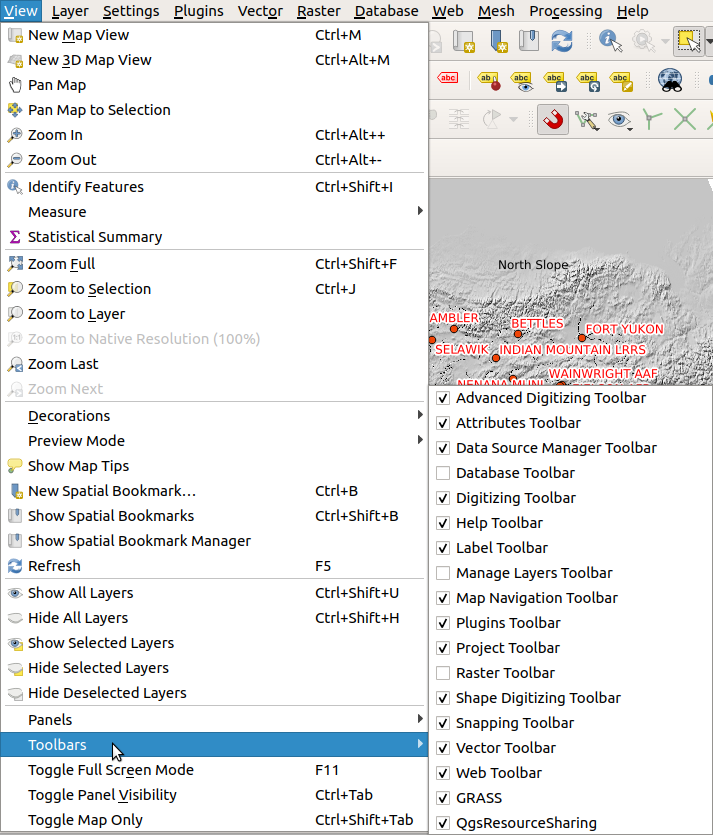
Fig. 7.2 The Toolbars menu
Tip
Restoring toolbars
If you have accidentally hidden a toolbar, you can get it
back using (or  ).
If, for some reason, a toolbar (or any other widget) totally
disappears from the interface, you’ll find tips to get it back at
restoring initial GUI.
).
If, for some reason, a toolbar (or any other widget) totally
disappears from the interface, you’ll find tips to get it back at
restoring initial GUI.
7.2.2. Panels
QGIS provides many panels. Panels are special widgets that you can interact with (selecting options, checking boxes, filling values…) to perform more complex tasks.
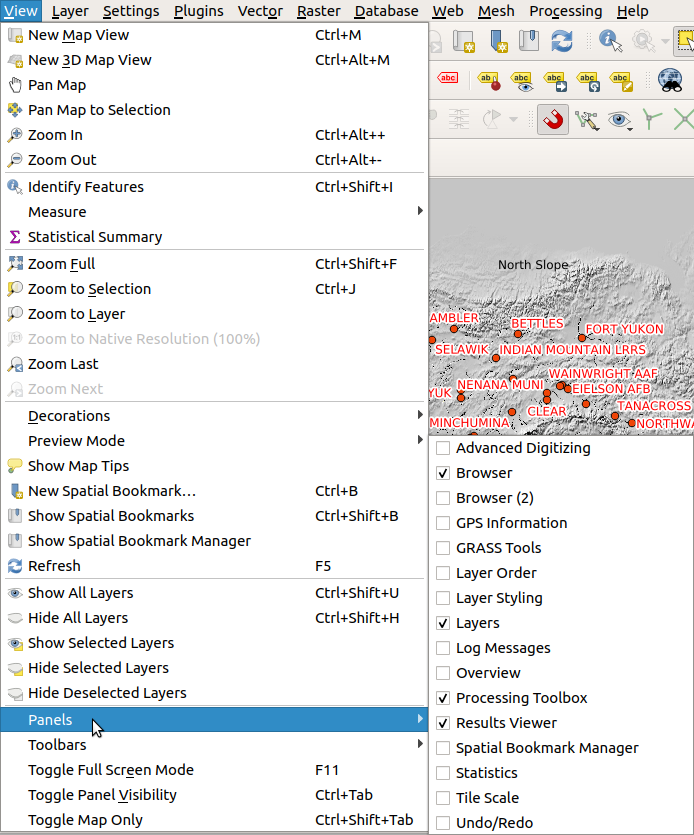
Fig. 7.3 The Panels menu
Below is a list of the default panels provided by QGIS:
the Browser Panel
the Identify Panel
the Layers Panel
the Overview Panel
the Result Viewer Panel
the Statistics Panel
the Tile Scale Panel
the Undo/Redo Panel
7.3. Map View
7.3.1. Exploring the map view
The map view (also called Map canvas) is the “business end” of QGIS — maps are displayed in this area. The map displayed in this window will reflect the rendering (symbology, labeling, visibilities…) you applied to the layers you have loaded. It also depends on the layers and the project’s Coordinate Reference System (CRS).
When you add a layer (see e.g. Opening Data), QGIS automatically looks for its CRS. If a different CRS is set by default for the project (see Project Coordinate Reference Systems) then the layer extent is “on-the-fly” translated to that CRS, and the map view is zoomed to that extent if you start with a blank QGIS project. If there are already layers in the project, no map canvas resize is performed, so only features falling within the current map canvas extent will be visible.
While the focus is over the map view:
it can be panned, shifting the display to another region of the map: this is performed using the
 Pan Map tool, the arrow keys,
moving the mouse while any of the Space key, the middle mouse
button or the mouse wheel is held down.
Pan Map tool, the arrow keys,
moving the mouse while any of the Space key, the middle mouse
button or the mouse wheel is held down.it can be zoomed in and out, with the dedicated
 Zoom In
and
Zoom In
and  Zoom Out tools. This is also performed by rolling
the wheel forward to zoom in and backwards to zoom out.
The zoom is centered on the mouse cursor position.
Zoom Out tools. This is also performed by rolling
the wheel forward to zoom in and backwards to zoom out.
The zoom is centered on the mouse cursor position.You can customize the Zoom factor under the menu.
it can be zoomed to the full extent of loaded layers (
 Zoom Full), to a layer extent (
Zoom Full), to a layer extent ( Zoom to Layer)
or to the extent of selected features (
Zoom to Layer)
or to the extent of selected features ( Zoom to Selection)
Zoom to Selection)you can navigate back/forward through canvas view history with the
 Zoom Last and
Zoom Last and  Zoom Next buttons
or using the back/forward mouse buttons.
Zoom Next buttons
or using the back/forward mouse buttons.
By default, QGIS opens a single map view (so called “main map”), which is tightly bound to the Layers panel; the main map automatically reflects the changes you make in the Layers panel area. But it’s possible to have additional map views to preview different renderings of your dataset, side by side; while still relying on the layers properties as set in the Layers panel, each map view can display a different set of layers at different scale and extent.
7.3.2. Setting additional map views
To add a new map view, go to  . A new floating widget displaying the layers
rendering is added to QGIS. You can add as many map views as you need.
They can be kept floating, placed side by side or stacked on top of each
other.
. A new floating widget displaying the layers
rendering is added to QGIS. You can add as many map views as you need.
They can be kept floating, placed side by side or stacked on top of each
other.
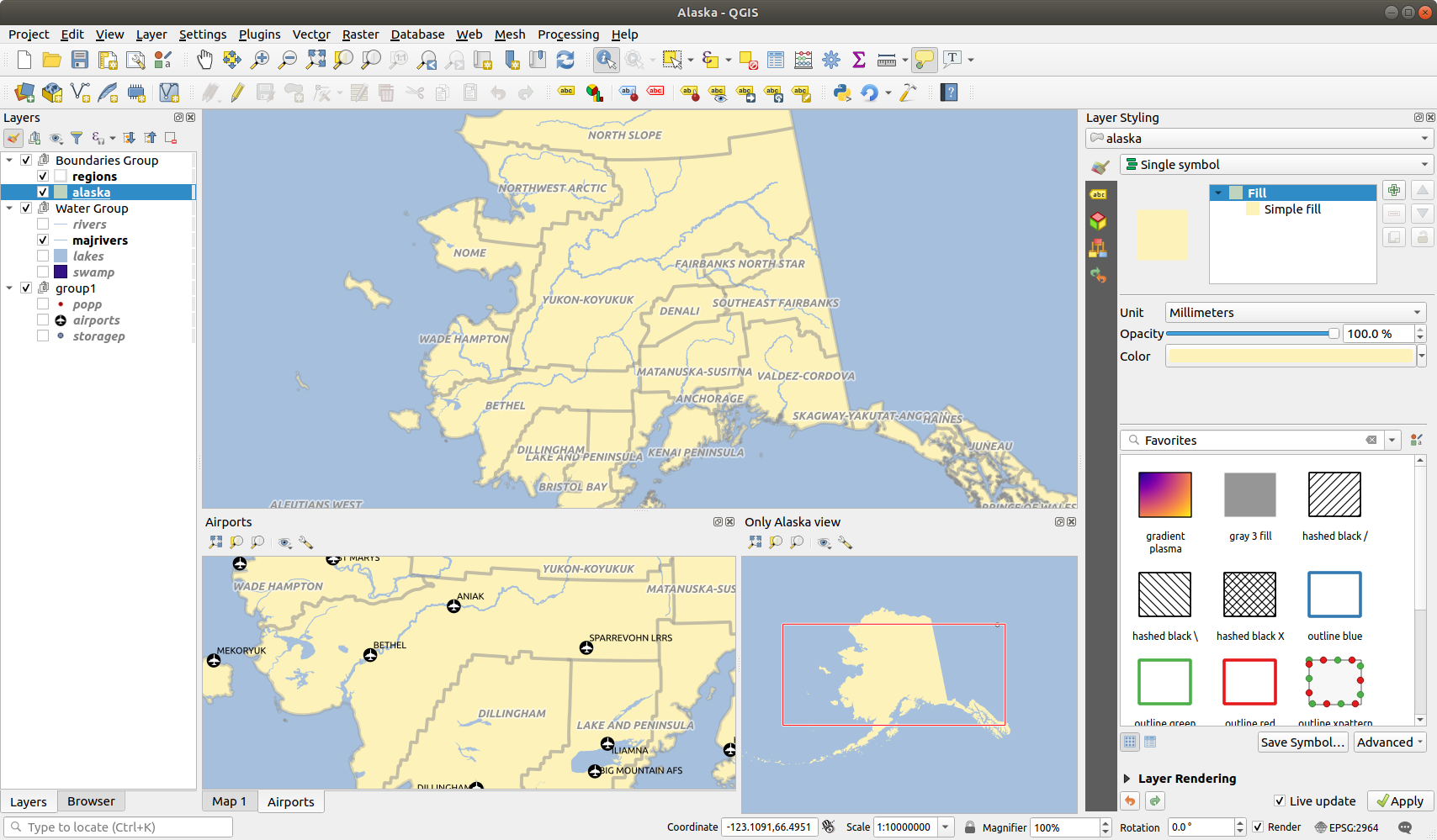
Fig. 7.4 Multiple map views with different settings
At the top of an additional map canvas, there’s a toolbar with following capabilities:
 Zoom Full,
Zoom Full,  Zoom to Selection
and
Zoom to Selection
and  Zoom to Layer to navigate within the view
Zoom to Layer to navigate within the view Set View Theme to select the map theme
to display in the map view. If set to
Set View Theme to select the map theme
to display in the map view. If set to (none), the view will follow the Layers panel changes. View settings to configure the map view:
View settings to configure the map view: Synchronize view center with main map:
syncs the center of the map views without changing the scale.
This allows you to have an overview style or magnified map which follows
the main canvas center.
Synchronize view center with main map:
syncs the center of the map views without changing the scale.
This allows you to have an overview style or magnified map which follows
the main canvas center.Scale
Rotation
Magnification
 Synchronize scale with the main map scale.
A Scale factor can then be applied, allowing you to have
a view which is e.g. always 2x the scale of the main canvas.
Synchronize scale with the main map scale.
A Scale factor can then be applied, allowing you to have
a view which is e.g. always 2x the scale of the main canvas. Show labels: allows to hide labels regardless
they are set in the displayed layers’ properties
Show labels: allows to hide labels regardless
they are set in the displayed layers’ propertiesChange map CRS…
Rename view…
7.3.3. Exporting the map view
Maps you make can be layout and exported to various formats using the advanced capabilities of the print layout or report. It’s also possible to directly export the current rendering, without a layout. This quick “screenshot” of the map view has some convenient features.
To export the map canvas with the current rendering:
The two tools provide you with a common set of options. In the dialog that opens:
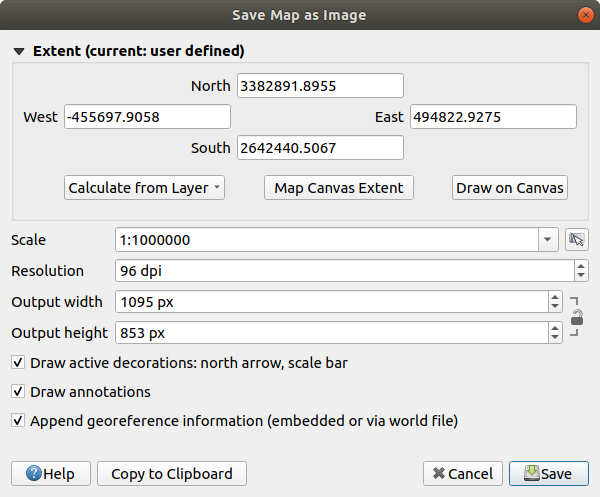
Fig. 7.5 The Save Map as Image dialog
Choose the Extent to export: it can be the current view extent (the default), the extent of a layer or a custom extent drawn over the map canvas. Coordinates of the selected area are displayed and manually editable.
Enter the Scale of the map or select it from the predefined scales: changing the scale will resize the extent to export (from the center).
Set the Resolution of the output
Control the Output width and Output height in pixels of the image: based by default on the current resolution and extent, they can be customized and will resize the map extent (from the center). The size ratio can be locked, which may be particularly convenient when drawing the extent on the canvas.
 Draw active decorations: in use
decorations (scale bar, title, grid, north
arrow…) are exported with the map
Draw active decorations: in use
decorations (scale bar, title, grid, north
arrow…) are exported with the map Draw annotations to export any annotation
Draw annotations to export any annotation Append georeference information (embedded or
via world file): depending on the output format, a world file of
the same name (with extension
Append georeference information (embedded or
via world file): depending on the output format, a world file of
the same name (with extension PNGWforPNGimages,JPGWforJPG, …) is saved in the same folder as your image. ThePDFformat embeds the information in the PDF file.When exporting to PDF, more options are available in the Save map as PDF… dialog:
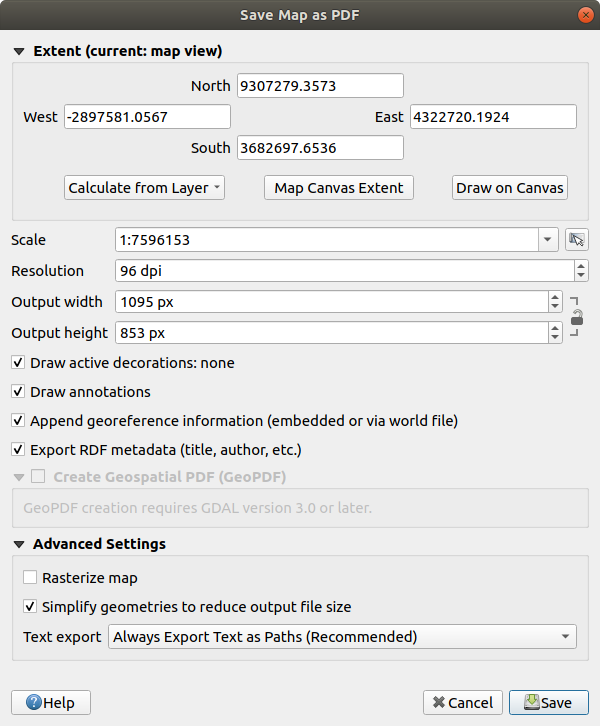
Fig. 7.6 The Save Map as PDF dialog
 Export RDF metadata of the document such
as the title, author, date, description…
Export RDF metadata of the document such
as the title, author, date, description… Create Geospatial PDF (GeoPDF):
Generate a
georeferenced PDF file
(requires GDAL version 3 or later).
You can:
Create Geospatial PDF (GeoPDF):
Generate a
georeferenced PDF file
(requires GDAL version 3 or later).
You can:Choose the GeoPDF Format
 Include vector feature information in the
GeoPDF file: will include all the geometry and attribute
information from features visible within the map in the output
GeoPDF file.
Include vector feature information in the
GeoPDF file: will include all the geometry and attribute
information from features visible within the map in the output
GeoPDF file.
Note
Since QGIS 3.10, with GDAL 3 a GeoPDF file can also be used as a data source. For more on GeoPDF support in QGIS, see https://north-road.com/2019/09/03/qgis-3-10-loves-geopdf/.
Rasterize map
 Simplify geometries to reduce output file
size:
Geometries will be simplified while exporting the map by removing
vertices that are not discernably different at the export
resolution (e.g. if the export resolution is
Simplify geometries to reduce output file
size:
Geometries will be simplified while exporting the map by removing
vertices that are not discernably different at the export
resolution (e.g. if the export resolution is 300 dpi, vertices that are less than1/600 inchapart will be removed). This can reduce the size and complexity of the export file (very large files can fail to load in other applications).Set the Text export: controls whether text labels are exported as proper text objects (Always export texts as text objects) or as paths only (Always export texts as paths). If they are exported as text objects then they can be edited in external applications (e.g. Inkscape) as normal text. BUT the side effect is that the rendering quality is decreased, AND there are issues with rendering when certain text settings like buffers are in place. That’s why exporting as paths is recommended.
Click Save to select file location, name and format.
When exporting to image, it’s also possible to Copy to clipboard the expected result of the above settings and paste the map in another application such as LibreOffice, GIMP…
7.4. 3D Map View
3D visualization support is offered through the 3D map view.
You create and open a 3D map view via
 .
A floating QGIS panel will appear. The panel can be docked.
.
A floating QGIS panel will appear. The panel can be docked.
To begin with, the 3D map view has the same extent and view as the 2D main map canvas. A set of navigation tools are available to turn the view into 3D.
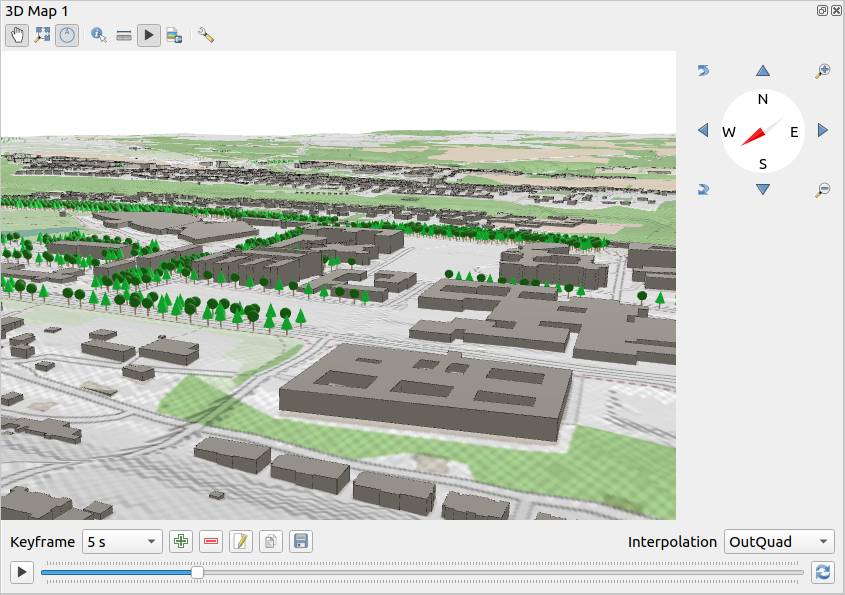
Fig. 7.7 The 3D Map View dialog
The following tools are provided at the top of the 3D map view panel:
 Camera control: moves the view, keeping the same angle
and direction of the camera
Camera control: moves the view, keeping the same angle
and direction of the camera Toggle on-screen notification: shows/hides the
navigation widget (that is meant to ease controlling of the map view)
Toggle on-screen notification: shows/hides the
navigation widget (that is meant to ease controlling of the map view) Identify: returns information on the clicked point
of the terrain or the clicked 3D feature(s) – More details at Identifying Features
Identify: returns information on the clicked point
of the terrain or the clicked 3D feature(s) – More details at Identifying Features Measurement line: measures the horizontal distance between points
Measurement line: measures the horizontal distance between points Animations: shows/hides the animation player widget
Animations: shows/hides the animation player widget Save as image…: exports the current view to
an image file format
Save as image…: exports the current view to
an image file format Configure the map view settings
Configure the map view settings
7.4.2. Creating an animation
An animation is based on a set of keyframes - camera positions at particular times. To create an animation:
Toggle on the
 Animations tool, displaying the animation player
widget
Animations tool, displaying the animation player
widgetClick the
 Add keyframe button and enter a Keyframe
time in seconds. The Keyframe combo box now displays the time set.
Add keyframe button and enter a Keyframe
time in seconds. The Keyframe combo box now displays the time set.Using the navigation tools, move the camera to the position to associate with the current keyframe time.
Repeat the previous steps to add as many keyframes (with time and position) as necessary.
Click the
 button to preview the animation. QGIS will generate scenes using
the camera positions/rotations at set times, and interpolating them in between
these keyframes. Various Interpolation modes for animations are
available (eg, linear, inQuad, outQuad, inCirc… – more details at
https://doc.qt.io/qt-5/qeasingcurve.html#EasingFunction-typedef).
button to preview the animation. QGIS will generate scenes using
the camera positions/rotations at set times, and interpolating them in between
these keyframes. Various Interpolation modes for animations are
available (eg, linear, inQuad, outQuad, inCirc… – more details at
https://doc.qt.io/qt-5/qeasingcurve.html#EasingFunction-typedef).The animation can also be previewed by moving the time slider. Keeping the
 Repeat button pressed will repeatedly run the
animation while clicking
Repeat button pressed will repeatedly run the
animation while clicking  stops a running animation.
stops a running animation.
It is possible to browse the different views of the camera, using the
Keyframe list. Whenever a time is active, changing the map view
will automatically update the associated position. You can also  Edit keyframe (time only) or
Edit keyframe (time only) or  Remove keyframe.
Remove keyframe.
Click  Export animation frames to generate a series of images
representing the scene. Other than the filename Template and the
Output directory, you can set the number of Frames per
second, the Output width and Output height.
Export animation frames to generate a series of images
representing the scene. Other than the filename Template and the
Output directory, you can set the number of Frames per
second, the Output width and Output height.
7.4.3. Scene Configuration
The 3D map view opens with some default settings you can customize.
To do so, click the  Configure… button at the top of
the 3D canvas panel to open the 3D configuration window.
Configure… button at the top of
the 3D canvas panel to open the 3D configuration window.
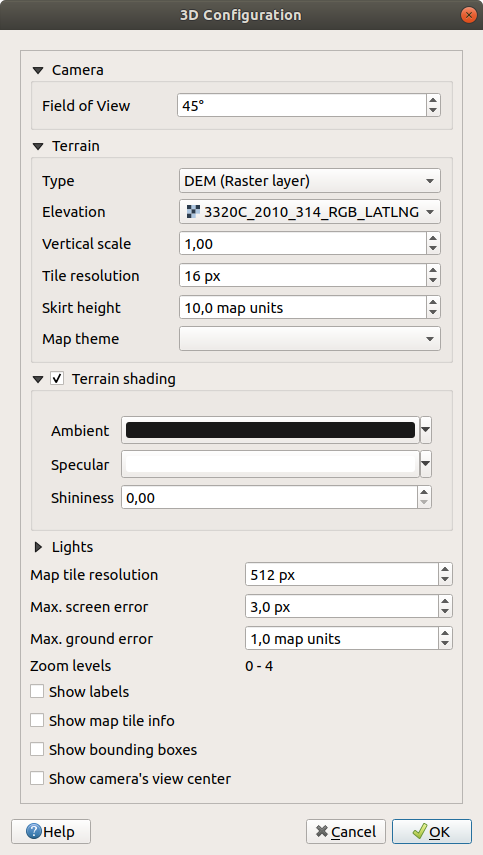
Fig. 7.8 The 3D Map Configuration dialog
In the 3D Configuration window there are various options to fine-tune the 3D scene:
Camera’s Field of view: allowing to create panoramic scenes. Default value is 45°.
Terrain: Before diving into the details, it is worth noting that terrain in a 3D view is represented by a hierarchy of terrain tiles and as the camera moves closer to the terrain, existing tiles that do not have sufficient details are replaced by smaller tiles with more details. Each tile has mesh geometry derived from the elevation raster layer and texture from 2D map layers.
The elevation terrain Type can be:
a Flat terrain
a loaded DEM (Raster Layer)
an Online service, loading elevation tiles produced by Mapzen tools – more details at https://registry.opendata.aws/terrain-tiles/
Elevation: Raster layer to be used for generation of the terrain. This layer must contain a band that represents elevation.
Vertical scale: Scale factor for vertical axis. Increasing the scale will exaggerate the height of the landforms.
Tile resolution: How many samples from the terrain raster layer to use for each tile. A value of 16px means that the geometry of each tile will consist of 16x16 elevation samples. Higher numbers create more detailed terrain tiles at the expense of increased rendering complexity.
Skirt height: Sometimes it is possible to see small cracks between tiles of the terrain. Raising this value will add vertical walls (“skirts”) around terrain tiles to hide the cracks.
Map theme: Allows you to select the set of layers to display in the map view from predefined map themes.
 Terrain shading: Allows you to choose how the
terrain should be rendered:
Terrain shading: Allows you to choose how the
terrain should be rendered:Shading disabled - terrain color is determined only from map texture
Shading enabled - terrain color is determined using Phong’s shading model, taking into account map texture, the terrain normal vector, scene light(s) and the terrain material’s Ambient and Specular colors and Shininess
Lights: You can add up to eight point lights, each with a particular position (in X, Y and Z), Color, Intensity and Attenuation.
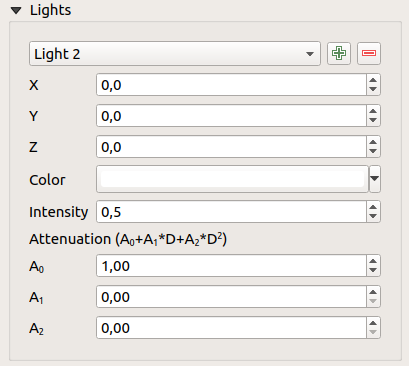
Fig. 7.9 The 3D Map Lights Configuration dialog
Map tile resolution: Width and height of the 2D map images used as textures for the terrain tiles. 256px means that each tile will be rendered into an image of 256x256 pixels. Higher numbers create more detailed terrain tiles at the expense of increased rendering complexity.
Max. screen error: Determines the threshold for swapping terrain tiles with more detailed ones (and vice versa) - i.e. how soon the 3D view will use higher quality tiles. Lower numbers mean more details in the scene at the expense of increased rendering complexity.
Max. ground error: The resolution of the terrain tiles at which dividing tiles into more detailed ones will stop (splitting them would not introduce any extra detail anyway). This value limits the depth of the hierarchy of tiles: lower values make the hierarchy deep, increasing rendering complexity.
Zoom labels: Shows the number of zoom levels (depends on the map tile resolution and max. ground error).
 Show map tile info: Include border and tile
numbers for the terrain tiles (useful for troubleshooting terrain
issues)
Show map tile info: Include border and tile
numbers for the terrain tiles (useful for troubleshooting terrain
issues) Show bounding boxes: Show 3D bounding boxes
of the terrain tiles (useful for troubleshooting terrain issues)
Show bounding boxes: Show 3D bounding boxes
of the terrain tiles (useful for troubleshooting terrain issues)
7.4.4. 3D vector layers
A vector layer with elevation values can be shown in the 3D map view by checking Enable 3D Renderer in the 3D View section of the vector layer properties. A number of options are available for controlling the rendering of the 3D vector layer.
7.5. Status Bar
The status bar provides you with general information about the map view and processed or available actions, and offers you tools to manage the map view.
On the left side of the status bar, the locator bar, a quick search
widget, helps you find and run any feature or options in QGIS.
Simply type text associated with the item you are looking for (name,
tag, keyword…) and you get a list that updates as you write.
You can also limit the search scope using
locator filters.
Click the  button to select any of them and press the
Configure entry for global settings.
button to select any of them and press the
Configure entry for global settings.
In the area next to the locator bar, a summary of actions you’ve carried out will be shown when needed (such as selecting features in a layer, removing layer) or a long description of the tool you are hovering over (not available for all tools).
In case of lengthy operations, such as gathering of statistics in raster layers, executing Processing algorithms or rendering several layers in the map view, a progress bar is displayed in the status bar.
The ![]() Coordinate option shows the current
position of the mouse, following it while moving across the map view.
You can set the units (and precision) in the
tab.
Click on the small button at the left of the textbox to toggle between
the Coordinate option and the
Coordinate option shows the current
position of the mouse, following it while moving across the map view.
You can set the units (and precision) in the
tab.
Click on the small button at the left of the textbox to toggle between
the Coordinate option and the  Extents option
that displays the coordinates of the current bottom-left and top-right
corners of the map view in map units.
Extents option
that displays the coordinates of the current bottom-left and top-right
corners of the map view in map units.
Next to the coordinate display you will find the Scale display. It shows the scale of the map view. There is a scale selector, which allows you to choose between predefined and custom scales.
On the right side of the scale display, press the  button
to lock the scale to use the magnifier to zoom in or out.
The magnifier allows you to zoom in to a map without altering the map
scale, making it easier to tweak the positions of labels and symbols
accurately.
The magnification level is expressed as a percentage.
If the Magnifier has a level of 100%, then the current map
is not magnified.
Additionally, a default magnification value can be defined within
,
which is very useful for high-resolution screens to enlarge small
symbols.
button
to lock the scale to use the magnifier to zoom in or out.
The magnifier allows you to zoom in to a map without altering the map
scale, making it easier to tweak the positions of labels and symbols
accurately.
The magnification level is expressed as a percentage.
If the Magnifier has a level of 100%, then the current map
is not magnified.
Additionally, a default magnification value can be defined within
,
which is very useful for high-resolution screens to enlarge small
symbols.
To the right of the magnifier tool you can define a current clockwise rotation for your map view in degrees.
On the right side of the status bar, there is a small checkbox which can be used temporarily to prevent layers being rendered to the map view (see section Rendering).
To the right of the render functions, you find the ![]() EPSG:code button showing the current project CRS. Clicking
on this opens the Project Properties dialog and lets you
apply another CRS to the map view.
EPSG:code button showing the current project CRS. Clicking
on this opens the Project Properties dialog and lets you
apply another CRS to the map view.
The  Messages button next to it opens the
Log Messages Panel which has information on underlying
processes (QGIS startup, plugins loading, processing tools…)
Messages button next to it opens the
Log Messages Panel which has information on underlying
processes (QGIS startup, plugins loading, processing tools…)
Depending on the Plugin Manager settings,
the status bar can sometimes show icons to the right to inform you
about availability of  new or
new or  upgradeable
plugins.
Click the icon to open the Plugin Manager dialog.
upgradeable
plugins.
Click the icon to open the Plugin Manager dialog.
Tip
Calculating the Correct Scale of Your Map Canvas
When you start QGIS, the default CRS is WGS 84 (EPSG 4326) and
units are degrees. This means that QGIS will interpret any
coordinate in your layer as specified in degrees.
To get correct scale values, you can either manually change this
setting in the General tab under
(e.g. to meters), or you
can use the ![]() EPSG:code icon seen above.
In the latter case, the units are set to what the project projection
specifies (e.g.,
EPSG:code icon seen above.
In the latter case, the units are set to what the project projection
specifies (e.g., +units=us-ft).
Note that CRS choice on startup can be set in .






















































































































































